
Despite we know thousands of extrasolar planets (exoplanets), only a small fraction of them have been discovered with direct imaging techniques, i.e. see in pictures, and have any information about their atmosphere or internal structure. The observational difficulties, such as the small brightness of the planet or the distorting influence of Earth’s atmosphere, forced the use of large-aperture telescopes and advanced optical systems (so called adaptive optics, AO) to search for planets via imaging. A good stroke of luck is also helpful. Additionally, to increase the chances of detecting a brown dwarf or a planet, astronomers have usually aimed at young and nearby stars. Still, in the vast majority of cases, no companion has been detected. Therefore, the astronomers started to look for a method of target selection in such a way as to maximize the chances of success.
One of the most promising ways of “preselection” turned out to be the use of astrometry, i.e. the search for changes in star’s proper motion. It is a vector that shows the direction and speed of the stellar movement across the sky. The ongoing Gaia mission provides high-precision positions and proper motions of stars. Same kind of data, although less precise, were delivered about 20 years ago by the Hipparcos satellite. By combining Hipparcos and Gaia data we can thus trace the proper motion across decades. As it turned out, in many cases Gaia measured a slightly different value than Hipparcos, meaning that the current direction and speed of the movement is not the same as 20 years ago. One of the reasons for that could be a gravitational pull from an unseen companion, which would cause the star to orbit around a common center of mass, on a long-period orbit (of the order of tens or hundreds of years).
Aiming at those “accelerating”[1], stars in order to search for planets, turned out to be a “bullseye”. In a recent paper, "Direct imaging and astrometric detection of a gas giant planet orbiting an accelerating star", published in the Science magazine, an international team of astronomers, which includes Krzysztof Hełminiak from the Copernicus Astronomical Center, presented the discovery of HIP 99770b, the first planetary-mass body detected jointly with astrometry and direct imaging[2].
The planets showed up on pictures taken in near infra-red with the SCExAO/CHARIS instrument, attached to the Subaru telescope, and the NIRC2 imager, behind the Keck II telescope. Additionally, the SCExAO/CHARIS data allowed to reconstruct the spectrum of the planet’s atmosphere, revealing the presence of water vapor and carbon monoxide. On top of that, the Hipparcos and Gaia data were not only used to select the target, but also to obtain the dynamical mass of the planet, which to date has only been done in several cases. Having 16 +/- 5 Jupiter masses, HIP 99770b is located at the “conventional” border between planets and brown dwarfs, however the planet-to-star mass ratio (q~0.0084) and the size of the orbit (a~16.4 AU) suggest the “planetary” formation scenario, from an instability in the accretion disk. The case of HIP 99770b proves that the archival astrometric data allow not only to discover planets more efficiently, but also to describe them in more details.
It is worth noting that it is not the first successful case of this method. In the late 2022, the same team of scientist, also with Krzysztof Hełminiak, presented a discovery of a brown dwarf around an “accelerating” member of the Hyades open cluster. In February of this year three independent groups announced detection of a 5 Jupiter mass planet around the star AF Lep.
[1]Any change of the velocity vector is called an acceleration.
[2]The results were accepted for publication already in July 2022, but the work itself was published only in April 2023.
Text: Krzysztof Hełminiak






